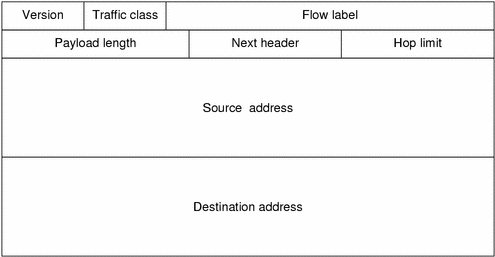The IPv6 protocol defines a set of headers, including the basic IPv6 header and the IPv6 extension headers.
Header Format

The basic IPv6 header contains 8 fields, in comparison with 12 fields in IPv4, for a total length of 40 octets. Below a list of the IPv6 header options:
Version(4 bit), This field contains the value 6 for IPv6.
Traffic Class(8 bit), Similar to the DSCP field in IPv4, this field is for being tagged with a DSCP value for special handling.
Flow Label(20 bit), This field is used to tag a flow for IPv6 packets. However the current IETF standard does not specify how to manage and process this field.
Payload Length(16 bit), This field represent the payload's length. The payload being the remaining part of the packet following the Ipv6 header.
Next Header(8 bit), Similar to the protocol field in IPv4, it specifies the type of information following the header. The type of information can be an upper layer protocol such as TCP or UDP or it can be one of the new optional extension headers.
Hop limit(8 bit), Similar to the TTL filed in IPv4, this field specifies the maximum number of hops that the IP packet can pass through.
Source Address(128 bit), This field specifies the IPv6 Source address.
Destination Address (128 bits), This field specifies the IPv6 destination address.
IPv6 Extension Headers
IPv6 extension headers are optional headers that may follow the basic IPv6 header. One Ipv6 packet may include 0, 1, 2 or more extension headers. They form a chained list of headers identified by the Next Header field of the previous header.
Below are some IPv6 defined extension headers:
Hop by Hop Options header(protocol 0)- This field is read and processed by every node and router along the path. The hop by hop header option is used for jumbogram packets and the router alert.
Destination Options header(protocol 60)- This header carries optional information that is specifically targeted to a packet's destination address. The mobile IPv6 protocol specification proposes to use the destination options header to exchange registration messages between mobile nodes and home agents.
Routing header(protocol 43)- This header can be used by an IPv6 source node to force a packet to pass through specific routers on the way to is destination.
No comments:
Post a Comment